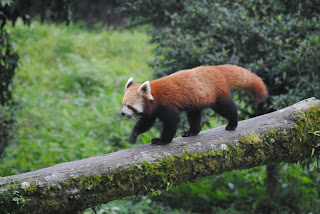The Giant panda (rather than the much smaller Red panda as illustrated) is being given a major boost in its native China (https://www.theguardian.com/world/2017/mar/31/china-to-create-giant-giant-panda-reserve-to-boost-wild-population). The intention is to link several reserves, creating a panda area of more than 27000 square kilometres. The Giant panda has already shown signs of an inprovement in its conservation status. Creation of the park will mean displacing around 170k people whose use of bamboo and grazing of cattle is seen as inimical to the project. Such as reserve would naturally also benefit many other animals and plants in that area. It is generally unappreciated by the general populice how large reserves have to be to accommodate viable breeding populations of large animals with substantial home ranges. Perhaps the Chinese Government is also perhaps starting to take an interest in the conservation of large mammals in other parts of the world, with new restrictions on ivory carving in that country. It will be interesting to see whether this has any real beneficial effects for the African elephant. Chinese 'medicine' continues, however, to threaten the Rhinoceros, Tiger and other animals
This blog may help people explore some of the 'hidden' issues involved in certain media treatments of environmental and scientific issues. Using personal digital images, it's also intended to emphasise seasonal (and other) changes in natural history of the Swansea (South Wales) area. The material should help participants in field-based modules and people generally interested in the natural world. The views are wholly those of the author.
Saturday, 1 April 2017
Pandering: The Chinese Way
The Giant panda (rather than the much smaller Red panda as illustrated) is being given a major boost in its native China (https://www.theguardian.com/world/2017/mar/31/china-to-create-giant-giant-panda-reserve-to-boost-wild-population). The intention is to link several reserves, creating a panda area of more than 27000 square kilometres. The Giant panda has already shown signs of an inprovement in its conservation status. Creation of the park will mean displacing around 170k people whose use of bamboo and grazing of cattle is seen as inimical to the project. Such as reserve would naturally also benefit many other animals and plants in that area. It is generally unappreciated by the general populice how large reserves have to be to accommodate viable breeding populations of large animals with substantial home ranges. Perhaps the Chinese Government is also perhaps starting to take an interest in the conservation of large mammals in other parts of the world, with new restrictions on ivory carving in that country. It will be interesting to see whether this has any real beneficial effects for the African elephant. Chinese 'medicine' continues, however, to threaten the Rhinoceros, Tiger and other animals
Subscribe to:
Post Comments (Atom)
-
I n the UK and US, a pparently popular and successful vegan/vegetarian restaurants are reportedly closing or adding meat to their menus ( ...
-
Early ripening fruit may seem convenient but some folk think it confirms environmental stress. There's also a possibility th...


%20mating%20NWCW.jpg)


No comments:
Post a Comment